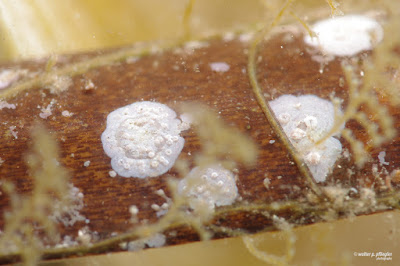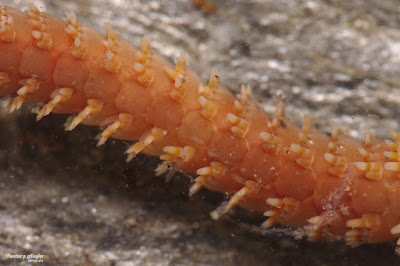At the trip in Greece, Sithonia Peninsula, I spent a lot of time searching for animals in the sea surroundung the village of Neos Marmaras. Luckily, the water was clean, the area was beautiful and I managed to find and photograph quite a lot of echinoderms, fish and molluscs. As I do not have an underwater camera, I took photos and videos of animals in small tidal pools and in shallow water. Location: Neos Marmaras. Date: 21-26.2011.
A görögországi úton a Sithonia-félszigeten sok időt töltöttem tengeri állatok keresésével Neos Marmaras falvának partjainál. Szerencsére a víz tiszta, a környék pedig gyönyörű volt és sikerült megtalálnom ill. lefotóznom elég sok különböző tüskésbőrűt, halat és puhatestűt. Minthogy víz alatti kamerám nincs, az állatokról a fotókat és videókat főleg a dagály által létrehozott kis medencékben ill. sekély vízben tudtam fotózni és videózni. Hely: Neos Marmaras. Dátum: 2011.21-26.
The shore around the village of Neos Marmaras:
A picture of the habitats on these rocky shores:
Egy kép a sziklás partok által nyújtott diverz élőhelyekről:
Another important habitat for many species are the underwater fields of Neptune Grass (Posidonia oceanica).
Egy másik fontos élőhely számos faj számára a neptunfű alkotta víz alatti mezők (Posidonia oceanica).


The leaves of the Neptune grass are used as substrates by some colonial animals; the name of these colony-forming hydroids is Aglaophenia harpago.
A neptunfű levelei több telepes állatnak is aljzatul szolgálnak; ezeknek a telepképző hidraállatoknak a neve Aglaophenia harpago.
The bryozoan Electra posidoniae lives also on the leaves.
Az Electra posidoniae nevű mohaállat szintén a leveleken él.
Fosliella red alga:
Fosliella vörösalga:
The rocks in the shallow littoral zone are covered with a dense vegetation of different algae. One of them is the spectacular Mermaid's Wineglass, the chlorophyte called Acetabularia. This is a single-celled alga that can reach a lenght of 5 cms, making it a perfect model organism to study certain biological phenomena. This alga was used by Joachim Hämmerling to demonstrate that the nucleus bears the genetic information of a cell.
A sekély littorális zónában álló köveket dús és változatos algaszőnyeg borítja. Az egyik ilyen alga a látványos 'sellőkehely', egy zöldmoszat, melynek latin neve Acetabularia. Ez egy egysejtű alga, mely 5 cm hosszúra is megnőhet. Ez a tulajdonsága tökéletes modellszervezetté teszi bizonyos biológiai jelenségek kutatására. Ezt az algát vizsgálva bizonyította be Joachim Hämmerling, hogy a sejtek genetikai információtartamát a sejtmag hordozza.
Green algae:
Zöldalgák:
Valonia sp:
Valonia-faj:
Brown alga:
Barnamoszat:
Among the algae, several sessile animals are also found on rocks, like these sea anemones (Anemonia viridis):
Algákon kívül számos szesszilis állat is él a köveken, mint ezek a tengerirózsák (Anemonia viridis):
Or their relative, the cup coral Balanophyllia europaea (a dead specimen):
Vagy rokonuk, a Balanophyllia europaea nevű korall (egy már elpusztult példány):
Tengeri makkok a Chthamalidae családból:
This big sponge, a Chondrosia reniformis was also growing on a rock:
Ez a nagyméretű szivacs (Chondrosia reniformis) szintén egy sziklán nőtt:
Aplysina aerophoba sponge:
Hengerszivacs (Aplysina aerophoba):
Another sponge:
Egy másik szivacs:
Ircinia sp sponge:
Ircinia sp szivacs:
with a tiny isopod:
egy apró ászkával:
The very shallow waters were home to these hermit crabs (Clibanarius erythropus):
A nagyon sekély vizek adnak otthont ezeknek a remeterákoknak (Clibanarius erythropus):
This Eriphia verrucosa crab lives in the intertidal zone:
Ez az Eriphia verrucosa tarisznyarák az árapályzónában él:
Ligia italica, an isopod of the intertidal zone:
Ligia italica, egy ászka az árapályzónából:
Maja sp spider crab:
Maja sp tengeri pók:
Mithracidae spider crab:
Mithracidae tengeri pók:
A sziklákon mindenütt tengeri sünök éltek, melyek az ott növő algákat fogyasztják. Legalább három fajukat láttam, a leggyakoribb az Arbacia lixula volt:
Sea urchins move about by their adhesive tube feet...
A tengeri sünök tapadólábaikkal mozognak...

...and feed with their strange mouthparts located on the underside. They have 5 calcium carbonate teeth. The entire chewing organ is known as Aristotle's lantern.
...és furcsa szájszerveikkel táplálkoznak, mely az állat alsó részén található. 5 db, kalcium-karbonátból álló foguk van. Magát a teljes szájszervet Arisztotelész lámpásának hívják.
This purple one is Paracentrotus lividus:
Ez a lila a Paracentrotus lividus:
This is an undetermined sea urchin:
Ez egy meghatározatlan tengeri sün:
I also found a test of a dead specimen. The spherical objects on these bear the spines of living animals. Also, the little pores are visible which enable the ambulacrar tube legs to protrude from the body.
Találtam egy elpuszult példány vázát is. A gömb alakú kinövések rajta a tüskék ízesülési helyei az elő példányokon. Láthatóak az apró pórusok is, melyek lehetővé teszik, hogy az ambulakráris lábak a test belsejéből kitüremkedjenek.
At the top of the animal, the gonopores and the anus is visible. The plate with the tiny pores is called the madreporite, it filters water into the water vascular system which moves the tube feet.
Az állat tetején a gonopórusok és a végbélnyílás látható. A lemez az apró pórusokkal a madreporit, amely vizet szűr a vízedényrendszer számára, ami pedig az ambulakráris lábakat mozgatja.


I found some brittle stars as well. This first one was among sea grass. It is a small species called Ophiothrix fragilis.
Találtam néhány kígyókarú tengeri csillagot is. Ez a példány tengeri fű között volt, ez egy kisméretű faj, neve: Ophiothrix fragilis.
Its much bigger relative is the Ophioderma longicauda, which can reach a diameter of 16 cms.
The relatives of sea urchins and stars are the bizarre sea cucumbers. I found 3 different species while we were there. The first is a 15-cm-long Holothuria poli.
A tengeri sünök és csillagok rokonai a bizarr tengeri uborkák. Három különböző fajukat találtam, amíg ott voltunk. Az első a 15 cm hosszú Holothuria poli.
This is a smaller Holothuria species:
All sea cucumbers have branched tentacles for feeding around the mouth:
A tengeri uborkák elágazó tapogatókkal rendelkeznek a szájuk körül, ezekkel táplálkoznak:
And an undetermined sea cucumber:
Some 1 m deep I found the Common Octopus (Octopus vulgaris):
More molluscs: the muricid sea snail Hexaplex trunculus, is quite common.
További puhatestűek: a Muricidae családba tartozó tengeri csiga, a Hexaplex trunculus elég gyakori.
Rough Cockle [Acanthocardia (Rudicardium) tuberculata]:
Csomós szívkagyló [Acanthocardia (Rudicardium) tuberculata]:
Rayed Trough Shell (Mactra stultorum):
Mactra stultorum kagyló:
Diodora gibberula keyhole limpet:
Diodora gibberula sapkacsiga:
Aplysia is a big nudibranch snail (a sea hare, 13 cm long) that eats algae:
Az Aplysia nevű nagyméretű csupaszkopoltyús csiga (13 cm) algákkal táplálkozik:
I found a very strange clam called the File Shell (Limaria hians). It has a hyaline shell and several long tentacles. It spends its time in nests made of debris and byssus (silky filaments) under stones. I it also a quite good swimmer. So it has a quite strange behaviour for a clam.
Találtam egy nagyon furcsa kagylót is (Limaria hians). Vékony héja és számos hosszú tapogatója van. Törmelékből és bisszuszból (selyemszerű fonadék) fészket készít magának kövek alatt. Valamint egész gyorsan úszik is. Kagylónak elég szokatlan viselkedésű tehát...
Some more invertebrates: this is a coral-like bryozoan (moss animal) that grows around Neptune grass rhizomes (Schizobrachiella sanguinea):
Néhány további gerinctelen: ez egy korallszerű mohaállat, mely a neptunfű rizómái körül nő (Schizobrachiella sanguinea):
A very interesting invertebrate that I found amond algae was a peanut worm (a member of the phylum Sipuncula), it is probably Phascolosoma granulatum.
Egy nagyon érdekes gerinctelen, melyet algák közt találtam ez a fecskendőféreg (a Sipuncula törzsbe tartozik), valószínűleg a Phascolosoma granulatum fajba tartozik.
Polychaete worm:
Soksertéjű gyűrűsféreg:
Some fish for the end: this nice red one is the male of the Blackfaced Blenny (Tripterygion tripterinotus). It belongs to the triplefins (the family Tripterygiidae).
Néhány hal a végére: ez a szép piros példány a Tripterygion tripterinotus, a háromúszójú nyálkáshalak családjába tartozik (Tripterygiidae).
This one is the male of the Anemone Goby (Gobius bucchichi):











































































































No comments:
Post a Comment